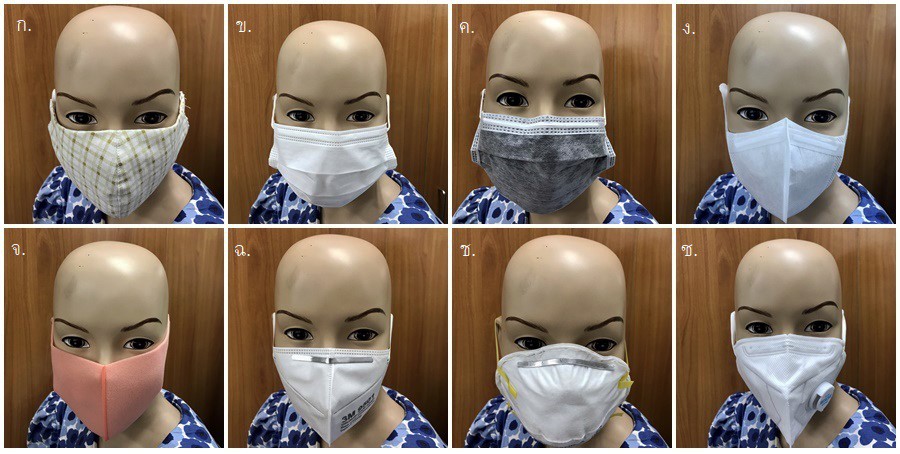การพัฒนารูปแบบหน้ากากป้องกันฝุ่นละอองขนาดเล็ก
Main Article Content
Abstract
Phannaphat Phromphen, Kanchana Suwanasri, Warangkana Hengpum, Sirinun Kaenthong and Jitsopha Chaleawsak
รับบทความ: 4 สิงหาคม 2563; แก้ไขบทความ: 31 มกราคม 2564; ยอมรับตีพิมพ์: 16 กุมภาพันธ์ 2564; ตีพิมพ์ออนไลน์: 13 พฤษภาคม 2564
บทคัดย่อ
ช่วงหลายปีที่ผ่านมา หลายจังหวัดของประเทศไทยมีดัชนีคุณภาพอากาศต่ำกว่าที่กำหนดเนื่องจากฝุ่นละอองขนาดเล็กในอากาศ (particulate matters: PM2.5) ก่อให้เกิดปัญหาต่อสุขภาพหลายประการ ผู้คนที่ต้องเผชิญกับปัญหาฝุ่นละอองขนาดเล็กจึงมีความจำเป็นต้องสวมหน้ากากหรืออุปกรณ์ป้องกันระบบทางเดินหายใจเพื่อป้องกันไม่ให้ฝุ่นละอองขนาดเล็กเข้าสู่ร่างกาย อย่างไรก็ตามหน้ากากที่มีประสิทธิภาพในการป้องกันฝุ่นละอองได้ดีหรือหน้ากาก N95 นั้นมีราคาแพง และหน้ากากอื่น ๆ ที่มีอยู่ในตลาดยังมีข้อจำกัดในการป้องกัน PM2.5 งานวิจัยนี้จึงมีวัตถุประสงค์เพื่อ 1) ศึกษาพฤติกรรมของกลุ่มที่ศึกษาในการใช้หน้ากากป้องกันฝุ่น PM2.5 และความต้องการหน้ากากกันฝุ่น 2) ออกแบบรูปแบบที่เหมาะสมและทำตัวอย่างหน้ากากด้วยวัสดุที่ตามความต้องการของกลุ่มที่ศึกษา และ 3) สำรวจความพึงพอใจของผู้บริโภคที่มีต่อหน้ากากที่พัฒนาแล้ว ผลการวิจัยพบว่า กลุ่มที่ศึกษามีปัญหาในการสวมหน้ากาก คือ มีความอึดอัดเนื่องจากหายใจไม่สะดวกและรูปแบบของหน้ากากไม่พอดีกับใบหน้า คณะผู้วิจัยจึงปรับรูปแบบของหน้ากากให้พอดีกับใบหน้า ทดสอบการซึมผ่านของอากาศตามมาตรฐาน ASTM D737–96 และทดสอบประสิทธิภาพการกรองฝุ่นของหน้ากากที่พัฒนาขึ้นด้วยวิธีการที่พัฒนาขึ้นในห้องทดลอง จากผลการทดสอบพบว่าการซึมผ่านของอากาศและประสิทธิภาพในการกรองฝุ่นของหน้ากากที่พัฒนายังอยู่ในระดับต่ำกว่าหน้ากาก N95 นอกจากนั้นผลการสำรวจความพึงพอใจของผู้บริโภคต่อหน้ากากที่พัฒนาขึ้นพบว่าผู้ทดสอบมีความพึงพอใจกับหน้ากากที่พัฒนาในด้านความสะดวกในการหายใจ ความสามารถในการป้องกันฝุ่นละอองขนาดเล็ก และรูปทรงของหน้ากาก
คำสำคัญ: หน้ากาก หน้ากากกรองอากาศ ฝุ่นละอองขนาดเล็ก พัฒนาผลิตภัณฑ์
Abstract
Recently, the air quality index (AQI) in many provinces of Thailand was lower than the standard due to the particulate maters in the air (PM2.5). This crisis may cause the health problem issue; therefore, people need to wear mask or respirator in order to prevent them from the small dust. However, the suitable masks or N95 respirators were expensive, and the other available masks were deficient for protection against PM2.5. This research aimed to 1) study the consumer behavior of the masks and the requirement of the mask, 2) design the suitable pattern and prepare the prototype for masks with the required material, and 3) survey the consumer satisfaction of the developed masks. The finding showed that the most common problems when wearing the masks were the uncomfortable feeling and the unfitted pattern. Thus, the style and pattern of the mask were adjusted. The air permeability and the particulate filtration efficiency of developed mask were also investigated by ASTM D737–96 and the in–house method. It was found that the air permeability and the particulate filtration efficiency of the developed mask was lower than the N95 respirator. Lastly, the consumer satisfaction of the developed masks was investigated. The result revealed that the participants were satisfied with the developed masks in the term of breathability, particulate protection ability and design.
Keywords: Face mask, Respirator, PM2.5, Particle matter, Product development
Downloads
Article Details

This work is licensed under a Creative Commons Attribution-NonCommercial 4.0 International License.
References
Borirak, T. (2020). The crisis lessons from PM2.5 air pollution. EAU Heritage Journal Science and Technology 13(3): 44–58. (in Thai)
Çelik, H. I. (2017). Determination of air permeability property of air–laid nonwoven fabrics using regression analyses. Periodicals of Engineering and Natural Sciences 5(2): 210–216.
Centers for Disease Control and Prevention. (1997). 42 CFR Part 84 Respiratory Protective Devices [Online]. Retrieved from https://www.cdc.gov/niosh/npptl/topics/respirators/pt84abs2.html, June 12, 2020.
Centers for Disease Control and Prevention. (2014). Non–occupational Uses of Respiratory Protection – What Public Health Organizations and Users Need to Know [Online]. Retrieved from https://blogs.cdc.gov/niosh-science-blog/2018/01/04respi rators-public-use, June 12, 2020.
Chairattanawan, K., and Patthirasinsiri, N. (2020). Emission source impact and problem solving and management on PM2.5 in the northern part of Thailand. Journal of the Association of Researchers 25(1): 461–474. (in Thai)
Cherrie, J. W., Apsley, A., Cowie, H., Steinle, S., Mueller, W., Lin, C, Horwell, C. J., Sleeuwenhoek, A., and Loh, M. (2018). Effectiveness of face masks used to protect Beijing residents against particulate air pollution. Occupational and Environmental Medicine 75(6): 446–452.
Chughtai, A. A., Seale, H., Dung, T. C., Maher, L., Nga, P. T., and MacIntyre, C. R. (2015). Current practices and barriers to the use of facemasks and respirators among hospital–based health care workers in Vietnam. American Journal of Infection Control 43(1): 72–77.
Gültekin, E., Çelik, H. I., Nohut, S., and Elma, S. K. (2020). Predicting air permeability and porosity of nonwovens with image processing and artificial intelligence methods. The Journal of the Textile Institute 111(11): 1641–1651.
Horwell, C. J., Ferdiwijaya, D., Wahyudi, T., and Dominelli, L. (2019). Use of respiratory protection in Yogyakarta during the 2014 eruption of Kelud, Indonesia: Community and agency perspectives. Journal of Volcanology and Geothermal Research 382: 92–102.
Imwinyan, P., and Kulsiri, P. (2015). Retail management influencing consumer’s buying behavior: A study of convenience stores in Bangkok Metropolis. VRU Research and Development Journal Humanities and Social Science 10(3): 349–359. (in Thai)
Jaichuen, S., and Sartmoon, S. (2020). Consumer behavior in accepting electronic health technologies health care air purifier. Rajapark Journal 14(32): 181–189. (in Thai)
Johnson, A. T. (2016). Respirator masks protect health but impact performance: A review. Journal of Biological Engineering 10(4): 1–12.
Li, Y., Tokura, H., Guo, Y. P., Wong, A. S., Wong, T., Chung, J., and Newton, E. (2005). Effects of wearing N95 and surgical facemasks on heart rate, thermal stress and subjective sensations. International Archives of Occupational and Environmental Health 78(6): 501–509.
National Institute of Health. (2019). Selection and Use of N95 Respirator: Public Knowledge [Online]. Retrieved from: http://nih.dmsc.moph.go.th/data/data/fact_sheet/2_62.pdf, June 12, 2020.
Navavongsathian, A. (2014). Behavior decision of consumer in online shopping store in Bangkok Metropolitan. Panyapiwat Journal 5(2): 134–149. (in Thai)
Panakobkit, W., and Sakunkoo, P. (2019). Us-age of respiratory protective equipment among sugarcane factory workers: Case study 3 province in Northeastern. KKU Journal for Public Health Research 12(1): 7–12. (in Thai)
Pholpibul T., Chaisawat, I., and Rungpisuttiphong, A. (2014). Disaster in the winter of particle matter (PM2.5). EAU Heritage Journal Science and Technology 8(14): 40–46. (in Thai)
Rengasamy, S., Eimer, B., and Shaffer, R. E. (2010). Simple respiratory protection–evaluation of the filtration performance of cloth masks and common fabric materials against 20–1000 nm size particles. Annals of Occupational Hygiene 54(7): 789–798.
U.S. food and drug administration. (2020). N95 Respirators, Surgical Masks, and Face Masks [Online]. Retrieved from https:// www.fda.gov/medical-devices/personal-protective-equipment-infection-control/n95-respirators-surgical-masks-and-face-masks, June 12, 2020.
Yip, W., Leung, L., Lau, P., and Tong, H. (2005). The effect of wearing a face mask on body temperature. Hong Kong Journal of Emergency Medicine 12(1): 23–27.
Zhou, S. S., Lukula, S., Chiossone, C., Nims, R. W., Suchmann, D. B., and Ijaz, M. K. (2018). Assessment of a respiratory face mask for capturing air pollutants and pathogens including human influenza and rhinoviruses. Journal of Thoracic Disease 10(3): 2059–2069.
